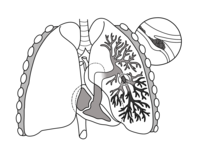
Photo from wikipedia
Pulmonary embolism can be acutely life-threatening and is associated with long-term consequences such as recurrent venous thromboembolism and chronic thromboembolic pulmonary hypertension. In 2020, the American Society of Hematology published… Click to show full abstract
Pulmonary embolism can be acutely life-threatening and is associated with long-term consequences such as recurrent venous thromboembolism and chronic thromboembolic pulmonary hypertension. In 2020, the American Society of Hematology published updated guidelines on the management of patients with venous thromboembolism. Here, a hematologist and a cardiology and vascular medicine specialist discuss these guidelines in the context of the care of a patient with pulmonary embolism. They discuss advanced therapies such as catheter-directed thrombolysis in the short-term management of patients with intermediate-risk disease, recurrence risk stratification at presentation, and ideal antithrombotic regimens for patients whose pulmonary embolism was associated with a transient minor risk factor.
Journal Title: Annals of Internal Medicine
Year Published: 2022
Link to full text (if available)
Share on Social Media: Sign Up to like & get
recommendations!